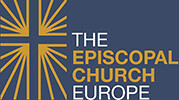Has Something Changed About You?
Category: Bishop's Sermons
Speaker: The Rt Rev Mark D.W. Edington
Tags: prayer, face, crisis, shine
The Cathedral Church of the Holy Trinity, Paris
February 27, 2022 • The Sunday Next Before Lent
Luke 9:29: "And while he was praying, the appearance of his face changed...."
I have not been here for a while, and so if I may I’d like to start in a somewhat odd way—by teaching you something about preaching. The source of this little bit of wisdom is the Danish philosopher and pastor Søren Kierkegaard, to whom I find myself returning again and again lately in these days of conflict and angst that is both political and spiritual.
Kierkegaard wrote a lot about preaching, as it turns out, and by no means do I encourage you to read it all; but these words are attributed to him, which seem to me to give me as good a starting point as any for this day:
“People have an idea that the preacher is an actor on a stage, and they are the critics, blaming or praising the result. What they don’t know is that they are the actors on the stage; the preacher is merely the prompter standing in the wings, reminding them of their lost lines.”
So just so we begin in the right place today, remember that my labors here for these few minutes are dedicated to helping you remember your lines.
I have noticed something recently, and I wonder whether you have noticed it too. The way it first came to my notice was just feeling a little bit less anxious, a little bit less tense—notwithstanding the awful events of these past days.
And then I realized that there was a simple reason for this. It’s that almost miraculously, as though it were part of the change of seasons, I am suddenly seeing other human faces. Noses! Mouths! Smiles! Teeth!
It has been so long. Of course, it’s not everywhere, at least not inside—but, oh, outside, walking along the Seine, seeing the whole faces of people—it’s something I never thought I would miss so much. The gentle nod of saying hello. The smile that says, “I see you,” or “thank you,” or “I love your dog.” All the world of non-verbal communication that we’ve been deprived of.
Surtout lorsque vous travaillez dans votre langue seconde—those little cues, those little helps, are kind of essential.
One of the deep theological truths I learned working in a behavioral science laboratory is that we humans read immense amounts of data from other people’s faces. We make almost instantaneous judgments about their social class, their ethnicity, even their moral character, from their faces. And much of what we decide in that instant is wrong.
And all of that is operating subconsciously to tell us, all the time and very quickly—am I safe? Is this person friend, or foe?
Few of us of a certain age who grew up in the United States escaped from high-school English class without reading Nathaniel Hawthorne’s short story “The Minister’s Black Veil.” The Reverend Mr. Hooper, the parson of Hawthorne’s fictional town of Milford, suddenly appears one Sunday morning with a veil of black crepe over his face; and from that point forward, for the rest of his brief life, he never removes it. Not for church, not for meetings, not even for conversation with his fiancée.
At the very first glimpse of their troubled parson an old woman exactly summarizes the disturbance this causes: “‘I don’t like it,’ [she] muttered..., as she hobbled into the meetinghouse. ‘He has changed himself into something awful, only by hiding his face.’”
And we come to know, as we learn the story, just why the people in that parson’s church see that veil as something awful. It is because by being confronted with what seems to be this man’s awareness of his own sins, they cannot escape a confrontation with their own, too.
Hawthorne knew his Bible, and he must surely have been aware of the contrast he was drawing between Parson Hooper and Moses. Parson Hooper wears a veil because of his profound awareness of God’s holiness; Moses wears a veil because he has been in the presence of God’s holiness.
This story of Moses happens at a pivotal point in the arc of the Exodus story. This is the second time Moses has been up the mountain to receive the covenant code, the ten commandments. The first time, while he was away for forty days, the people got impatient and built an idol to worship. That was, to put it mildly, a cause of disruption in the relationship. When he comes back and sees what has happened, Moses breaks the tablets of stone in his anger.
This time, God has called Moses back up the mountain. He tells him to bring two new tablets. But this time, the story is headed in a different direction. Because when it is over, God is going to come and dwell directly among the people—in the tabernacle, the tent of meeting.
After this happens, God will stay with God’s people, a presence among them. At the very end of Exodus, a cloud settles on the tent of meeting, and God’s glory comes to dwell with them.
So that radiance of Moses’s face is a sign of things to come. In a crucial moment in his people’s history, he has gone up the mountain—which is another way of saying, he has brought himself as close as possible to God in prayer. And because of that, he is changed—changed in such a way that people can see his relationship with God has changed him, in a way that God intends for it to change them, too. The message is that God will be with them, so that all of them can draw near to God in prayer. And if they do, they will be changed, changed into the people God is calling them to be.
It is no accident that the architects of the lectionary have brought together for us the Exodus story of Moses and the story of Jesus’s transfiguration. Because for the first Christians, the Transfiguration story was a profoundly Jewish story, one that echoed a part of the story of Jewish liberation that even non-Jews would have known.
This story, too, comes at a pivotal moment in the story. It is the hinge between the beginning and the end of Jesus’s earthly ministry. Because not long after this moment, not long after Jesus comes back down the mountain, Luke will announce that turning point with these words: “He set his face”—that same shining, transfigured face— “he set his face to go to Jerusalem.”
If the story about Moses pointed toward a time that God would come to dwell among the people, Luke is telling us that story with a different ending—God has come to dwell among the people, in the person of Jesus.
And again, the arc is the same: It is a pivotal moment in the history of God’s story; Jesus has brought himself close to God in prayer. And when it is all over, Jesus doesn’t need a veil to obscure or avoid God’s presence—because he is God. He doesn’t simply reflect God’s glory; he is God’s glory among God’s people.
There is no more need for a tabernacle; God in Christ has come to dwell among us as one of us.
These two stories are different in their specifics, but they are bound together by a common theme: In crucial moments, we sense a need to draw close to God in prayer; and when we do, something about us, something others can see, changes. Something shines. Something helps others see God at work in us.
Well, this is a crucial moment. This is an anguishing moment. People who are our neighbors, people in Ukraine are in agony at this very moment. They are desperate to hold on to their dignity as an independent country.
For most of us here this morning, we have rarely if ever lived through days in which events that will shape the future for our children and grandchildren, their possibilities and their prospects, have hung in the balance.
We cannot see today how this will unfold, what all this will mean—not just for Ukraine, but for Europe; not just for nations, but for our hopes, for the fundamental ideas of human rights, and self-determination, the sovereignty of the people—all of which are different expressions of the same basic idea, the idea of human dignity.
And at just this moment, people of God, the veils are coming off our faces. And I am wondering—the people around you are wondering—has something changed about you? Have you been risking praying?
If there has ever been a moment in our lives when it was time for us to draw nearer to God in prayer, this is that moment. Not the sort of laundry-list prayers that we tend to stack up with God; the kind of prayer that pleads before God the treatment we think we’re entitled to.
No, it is the prayer that risks being in the presence of God, prayer that is more about our silence than our speaking, prayer that is more about our listening than our longing. Prayer that will quiet us, guide us, assure us, and change us.
My fellow-ministers, even though the spring is coming, even though it feels like the pandemic is ending, these are dark days. And it may well be that the days ahead grow darker still. The people around us—the world around us—desperately needs our shining faces. They need to know to see a difference in us because we have dared to draw near to God—because they are desperate to know there is a God to draw near to, a God who will still vindicate what is right and good and true.
Lent is nearly upon us. We could do worse than spending it finding new ways to dare that practice of prayer. The church is here to help with that. So here’s your line for Lent—are you ready? When you see your friends here, when we greet each other as fellow-minsters, here’s your line: Has something changed about you? You look different somehow. You have this—I don’t know, glow. What have you been doing?
And then, if you are the one on the other end of that question, tell them, friends. Tell them. Amen

